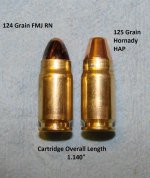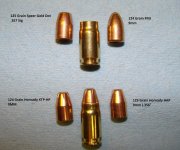I'm now scratching my head. So, lighter bullets will have MORE "bearing surface"?
Just getting into reloading, and .357 SIG is one of the calibers I will be doing.
No not more bearing surface
357SIG has a very short neck. many heavier (longer) projectiles have their bearing surface ending up too far inside the case, thus it is not aligned in the neck for good tension.
I started shooting 357SIG in 1993. I was working in Dallas County and I had access to some of the Texas DPS guys that were involved with the evaluation of the cartridge. That is where I shot my first SIG P229
I used to go through LOTS of 357SIG (6000+ annually). I have loaded tens of thousands of rounds over the years. These days it loads just as smoothly as 45 ACP or 357 Magnum
lrrifleman,
As STORMINORMAN points out that Lee FCD imparts a collet crimp that virtually eliminates neck tension issues as long as the profile of your projectile puts some of the bearing surface at the case mouth. Before discussing with LEE about the possibilities of a collet crimp die for this cartridge, I reduced the diameter of the expander plug by a little over .001" to try and increase neck tension with some of the iffy projectiles
The Montana Gold 357SIG projectiles are great as are the Hornady XTPs and HAPs. It is that truncated cone shape that works so good with this cartridge. I am not sure if I ever loaded plated in this cartridge due to the velocities.
I have a cute 90 grain JHP that leaves my SIG X5 at 1700 FPS when pushed by a nice charge of Power Pistol. It is Extremely accurate in my SIG P229 Sport
Prior to our current Constitutional Crisis this projectile was very reasonably priced even if I only bought a few thousand at a time
That 90 JHP load moves out even faster from my 8.9" MP5, though I have not chronographed it
I have not loaded anything above 147/150s though I have a buddy that goes over 160 grains with a custom made JHP. I only go heavy for suppressed use. Most of what I load are 124/125s or the 90s
I load on a five stage progressive press and like STORMINORMAN my first die is a carbide 40 S&W sizer. Without that the handle pressure on my press was excessive. Now I do lube the cases with Hornady One Shot. Every few hundred rounds I give a little squire into the 5 gallon bucket of grass and do a quick hand stir
Station 2 is the 357SIG sizing die and priming. I did have a chance to try the Dillon carbide die on the press but it made no appreciable difference in handle force needed over a steel sizer even though it cost 4-5 times as much
Station 3 drops powder and expands the case mouth
Obviously I seat and crimp at stations 4 and 5 respectively





